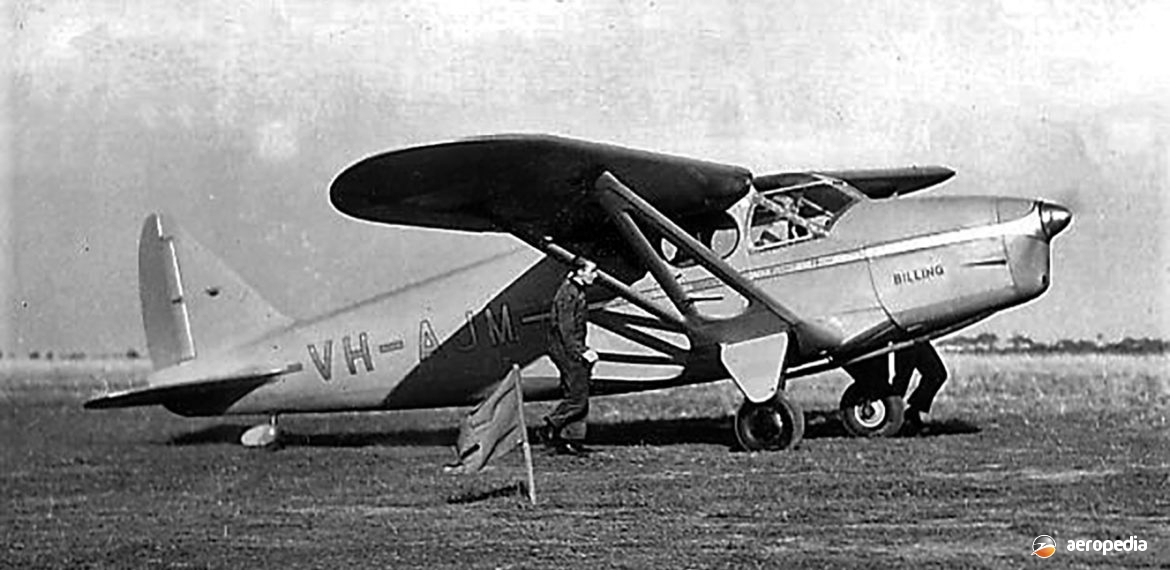Photograph:
Heston Phoenix VH-AJM (c/n 1/2) in 1936 ( Frank Walters collection)
Country of origin:
United Kingdom
Description:
Light commercial transport
Power Plant:
One 149 kw (200 hp) de Havilland Gipsy Six Series VI six-cylinder inverted in-line air-cooled engine
Specifications:
- Wingspan: 12.3 m (40 ft 4 in)
- Length: 9.2 m (30 ft 2 in)
- Height: 2.65 m (8 ft 7 in)
- Wing area: 25.26 m² (272 sq ft)
- Max speed: 238 km/h (148 mph)
- Cruising speed: 201 km/h (125 mph)
- Landing speed: 89 km/h (55 mph)
- Initial rate of climb: 213 m/min (700 ft/min)
- Service ceiling: 4,724 m (15,500 ft)
- Cruising range with full load: 805 km (500 miles)
- Cruising range: with max fuel: 1,207 km (750 miles)
- Empty weight: 962 kg (2,120 lb)
- Loaded weight: 1,497 kg (3,300 lb)
History:
The Heston Phoenix was built by the Heston Aircraft Company Ltd at Heston in the Hounslow district of south-west London, the company rising out of the demise in 1934 of the Comper Aircraft Company Ltd. Designed by George Cornwall, the prototype Phoenix G-ADAD (c/n 1/1) first flew on 18 August 1935 flown by Edmund Hordern. Certification trials were carried out at Martlesham Heath in Ipswich.
The Phoenix Series I was an orthodox single-engine aircraft, having a high-wing and a fully-retractable Dowty hydraulically-operated inward- retracting undercarriage. Accommodation was provided for five persons, with 45 kg (100 lb) of luggage, and it was noted for its generous leg-room and quiet cabin. The Gipsy Six VI engine provided 149 kw (200 hp) and, driving a fixed-pitch wooden propeller, gave it good performance for the time.
The aircraft was of all-wood construction, with a plywood-covered fuselage structure changing to semi-monocoque aft of the cabin, which formed the frame-built forward portion. Plywood was used in the covering for the tailplane and fin, and for the leading-edge of the two-spar wing, but the rest of the surfaces were fabric covered. With a full complement on board, 45 kg (100 lb) of luggage and fuel, the aircraft had an 805 km (500 miles) range at 201 km/h (125 mph).
Only a small production batch was completed. The prototype was sold to a Greek air-taxi firm as SX-AAH. Other production aircraft were: G-AEHJ (c/n 1/3), a series I, which operated with British American Air Services Ltd.
G-AEMT (c/n 1/4) was operated by No 4 Squadron Royal Air Force (RAF) at Farnborough, then went to the Luton Flying Club, later to the RAF Maintenance Command in March 1940 as X9393, and was struck off charge in 1943.
G-AESV (c/n 1/5), a Series II, was sold to Standard Telephones and Cables Ltd at Hatfield in Hertfordshire, later going to RAF Maintenance Command as X2891, but being destroyed when it crashed in the French Alps in 1952.
G-AEYX (c/n 1/6) was operated with a number of owners in the United Kingdom until impressed by the RAF as X9338. It was reduced to scrap in 1944.
A development of the Phoenix planned by Heston was the six-seat Griffin, a 216 kw (290 hp) Wolseley Scorpio powered variant, which was never built. The Company was also known for the Heston Racer (G-AFOK) in 1936, a racing aircraft powered by a 1,723 kw (2,310 hp) 24-cylinder Napier Sabre liquid-cooled engine designed by A E Hagg and G Cornwall. The aircraft was first flown on 12 June 1940 but crashed on its first test flight.
One Phoenix was imported to Australia. This aircraft, a Phoenix Series 1 registered VH-AJM (c/n 1/2 – ‘Billing’), was imported by Charles James “Jimmy” Melrose, famous in the 1930s for making long-distance flights in light aircraft. The aircraft received Registration No 584 on 1 May 1936. Melrose flew the aircraft to Australia, leaving Heston on 9 April 1936 and arriving in Adelaide, SA on 29 April. He used the aircraft as a taxi aircraft from Adelaide, calling his business Adelaide to Anywhere. One passenger was the South Australian Premier at the time, Mr Butler. Many good-will flights were made, and Melrose used the aircraft to promote the South Australian Centenary, on occasions delivering brochures to country towns and interstate.
On one occasion Melrose accepted a charter by a Mr Alexander Campbell, a mining engineer with Broken Hill Pty Ltd, to fly him from Broken Hill, NSW to Adelaide, and then on to Oodnadatta, SA and Darwin, NT. Other BHP personnel were to join the flight along the way. The flight commenced from Hart’s hangar at Essendon, VIC on 4 July 1936. It is believed Melrose was following the Melbourne to Adelaide railway line for navigation purposes in poor weather.
Melrose and his passenger were killed when the Phoenix crashed near Melton, VIC at 8.34 am on 5 July 1936. Some reports stated it was hit by lightning. Others indicated the aircraft broke up in the air, the starboard wing coming off in flight. Records indicated on 30 May 1936 Melrose in the Phoenix made a heavy landing at Kingscote Aerodrome on Kangaroo Island, SA but there was no visible damage, even though the passenger said he heard a cracking sound from the main spar. The Coronial Inquest put the crash down to structural failure and adverse weather conditions.

